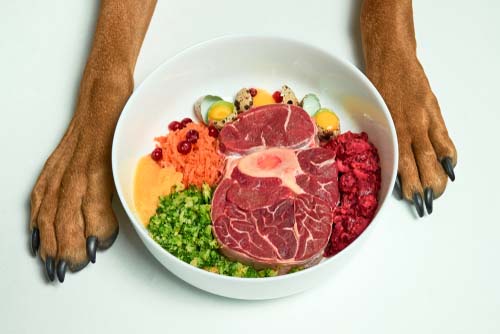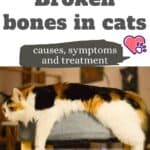
The BARF diet is in vogue and has multiple benefits for pets, but it has little scientific support and poses several risks to their health … and yours
If you do not have a dog or cat around you, you have probably never heard of it, but it is an upward trend (with repercussions on human health). We talk about the BARF ( Bones And Raw Food ) diet ; of bones and raw food. Or, in a successful advertising evolution, food biologically appropriate raw ( Biologically Appropiate Raw Food ) . The BARF diet consists of including raw ingredients of animal origin (meat, organ meats, bones, milk or eggs) in the diet of domestic dogs and cats. And it is controversial, because it has little support from the institutions in charge of animal and human health, and it carries risks.
BARF diet for dogs: what benefits does it offer?
The BARF diet is based on the principle according to which the dog must be fed healthy and natural food; it is considered the best diet for the animal to recover its evolutionary diet, that is the one genetically suitable for it.
The BARF diet for dogs is based on the consumption of foods considered more natural and suitable for the animal’s body. The abbreviation BARF in fact means Biologically Appropriate Raw Food , also known as the ACBA diet, or Biologically Appropriate Raw Food .
This diet is considered the best food plan for the dog to recover its evolutionary nutrition, with all the consequent benefits for its health.
To adopt the BARF diet, one must purchase foods such as meat, fish, fruit and vegetables . These foods are free of chemicals instead found in treats sold in pet stores.
Its supporters claim that the BARF diet allows the dog to reach its full genetic potential in terms of health, longevity, physical activity and reproduction. In other words, the dog’s diet must resemble as much as possible its evolutionary diet, that is, the one adapted to its body.
Portions of meals
Properly prepared, this diet is very balanced . If you are thinking of adopting it for your dogs, remember that the pet must be guaranteed the correct rations of vitamins, proteins and antioxidants.
Meat is the main ingredient: it makes up 60-80% of the BARF diet. She must be lean and low in fat. The best meats are therefore white ones, such as turkey or chicken. However, lamb, veal or fish are also good.
Fruits and vegetables represent the remaining 20-40% of the BARF diet. Although the dog can eat a wide variety of plant foods, he must avoid some of them. Vegetables unsuitable for dogs include grapes, avocados, citrus fruits and tomatoes.
Dogs can eat spinach, chard, celery, potatoes and broccoli. In addition to these foods, cauliflower, peppers, turnip, pumpkin and carrot are also indicated.
Orange-colored vegetables, such as carrots and squash, contain an abundance of vitamin A. We recommend offering the dog as much vitamins and minerals as possible.
As for fruit, the dog can eat almost any fruit in season: apples, pears, bananas, apricots, papayas, berries, strawberries or berries are great options. The wider the range of fruits and vegetables administered, the greater the amount of nutrients and vitamins offered to the dog .
Benefits of the BARF diet for dogs
The BARF diet offers several benefits . These include improvements in physical performance, mood and health.
Physical benefits include a healthier , stronger, and shinier coat . In addition to this, this diet considerably improves the dog’s body odor and eliminates tartar from the teeth . We will also notice a change in the stool: smaller quantities, less pungent odor and appropriate consistency.
Many cases report a considerable increase in the dog’s energy and vitality.
Another advantage offered by this diet is the increased appetite on the part of the animal. Thanks to the variety of flavors, textures and aromas included in this diet, we stimulate the dog’s appetite and encourage him to eat with more pleasure.
In addition, by eating products that are free of chemicals and that have not undergone food processing, the animal will be healthier and live longer.
A more balanced diet increases the animal’s muscle mass, as well as its resistance to internal and external parasites and reduces the risk of suffering from diabetes. There are many advantages that derive from adopting the BARF diet for the dog and in a few weeks you will already see the difference.
How to adopt the BARF diet for dogs
We need to make sure that we feed the right portions to the animal which, otherwise, would not eat enough. This would harm his health and could cause nutritional deficiencies , so he would be more prone to contracting diseases.
We must reserve the same attention and hygiene for preparing food for dogs as we do for ours. Meat and fish must be frozen before consumption in order to eliminate bacteria and parasites. We can then cook them on the grill or steamed to be sure that they have completely eliminated the bacteria.
It is advisable to cut the food into pieces that are not too small . In this way we force the animal to chew, which releases endorphins, the hormones of happiness, and promotes its oral hygiene .
In addition to what has already been said, the BARF diet involves the administration of fleshy bones . These must be soft, raw and proportional to the size of the dog, but above all to its digestive capacity. It is not recommended to give the animal cooked bones, because they tend to break more thus increasing the risk of accidents.
If your dog is used to eating treats, he may initially reject this new meal plan. It will therefore be necessary to gradually include him in his daily life.
You can include small portions of the BARF diet in his usual meals , and then increase the quantities little by little.
Before adopting this new style of food for your dog, you need to be well informed.
It is very important to prepare food respecting precise hygiene rules and to guarantee the animal the right portions. The ideal is to define the BARF diet for the dog with the help of a nutritionist veterinarian .
Does it make sense to feed raw food to pets?
Intuitively, the idea is very good: bring the feeding of pets closer to the diet they would follow if they were free in a natural environment to improve their quality of life and prevent health problems. It seems like a seamless approach. But it breaks down when it is put into practice , the moment it goes from theory to the real conditions in which our pets live (which are not even close to those they would have in the wild).
It is not logical to pretend to domesticate an animal and that nothing changes in its biology. It is true that wolves, ancestors and model that a dog might look like in the wild, have a limited ability to digest carbohydrates. But they also have a much lower life expectancy in a completely different environment. Dogs are no longer wolves, and in this evolution they have incorporated various genetic changes , including the ability to digest starch or changes in fat metabolism (aspects that are considered crucial in domestication).
Who Invented the BARF Diet?
The push to the BARF approach came in the 90s from the hand of publications without scientific basis , and it is a trend that has been gaining ground in a context in which there are not only more dogs and cats in homes, but also Furthermore, they are no longer mere animals we live with, but part of the family to a greater or lesser degree.
It is emotionally complex to establish such a deep bond with a living being that he will depend completely on his “human” for his entire life and that, predictably (and in the best of cases), will die before him. This is the laudable reason that has facilitated the growth in popularity of BARF diets among pet owners: the pursuit of the well-being of their animals.
It has researched the specific reasons leading to interest in this type of food . They emphasize respect for the carnivorous nature of dogs or improve their health. But a previous bad experience with animal food, mistrust in commercial brands of feed or the presence of additives (the same fear that we have with human food) also weighs heavily. Some food crises have contributed to this concern.
BARF diet and FDA
In 2007, animal food from China adulterated with melamine (a substance used as a source of nitrogen) caused numerous deaths of pets in the US and caused the legislation to be changed. The spread of hoaxes about feed , or the recall of products due to different non-compliances (something that is also done in human food and shows that the control system works), have also given rise to the idea that commercial food is not to be trusted .
To top it all off, the investigation opened by the FDA (US Food and Drug Administration) to study the possible relationship between the consumption of “grain-free” feed (which is considered to be of higher quality) and the development of cardiomyopathies also extends suspicions to the “premium” range, although this association has not been proven and no recommendations have been issued to avoid these brands. To these reasons are also added social, cultural and ethical components: if feed is made with by-products that humans do not eat, why give it to animals?
What benefits does the BARF diet promise?
The BARF diet is proposed as the dietary strategy to achieve a whole range of benefits for the animal: strengthening the immune system, improving the health of the teeth, skin and gastrointestinal tract, reducing the risk of cancer … it is even postulated as the way to achieve positive effects on their behavior.
What the theory says
The theory is that all this would be achieved only from raw foods of animal origin; mainly meat, offal and bones. Foods that, if cooked, would lose those properties, since cooking would destroy “good” microorganisms that improve intestinal flora.
According to the theory, if there is no heat treatment, there is no alteration of the proteins, the enzymes that they naturally have remain intact, and this would improve digestibility by allowing better absorption. In addition, there would be changes in the intestinal flora that, together with the contact with the microorganisms in the meat, would reinforce the immune response.
What reality shows
The reality is that, despite the fact that its supporters try to rely on research with apparent legitimacy, there is no scientific evidence to support these results. As collected by some quality reviews, the studies are scarce and there is no information on the long-term effect . Only a certain beneficial effect has been found on the intestinal flora and the quality of the stool. That’s it. In contrast, robust research advises against this practice for nutritional and food safety reasons.
Raw food diet, why are they a risk?
The BARF diet poses real food safety risks for pets, but also for people.
Risks of the BARF diet for your pet
On the one hand, the suitability of diets based on raw foods (either from commercial products or made at home) depends exclusively on the knowledge of the owners (who, in turn, follow advice without scientific endorsement issued by people no training). The result is that, analyzed under the magnifying glass, they present imbalances in their nutrient content , as reflected in various studies.
Furthermore, some apparent benefits observed by owners, such as that animals have more lustrous hair, is due to the high fat content of the diet, which can cause gastrointestinal disturbances and increase the risk of obesity.
But, in addition, this diet poses a real physical risk by incorporating bones that can cause dental fractures or intestinal obstructions . Although it is alleged that uncooked bones do not cause this damage, there is no evidence of this .
BARF supporters propose that both the digestive system and the immune system of dogs and cats are different from ours, and that these pathogens do not make them sick. Is not true. Of course, they can become ill with manifestations similar or different to ours (that diarrhea does not appear, for example) and they can also die. But most owners don’t even consider the possibility that raw food could pose a risk of food poisoning to the animal.
What’s more, the companies that market BARF meat lack the knowledge to the point of ensuring that their product is free of pathogens because it is subjected to a quick freeze that destroys them. I wish it was that easy. Cold temperatures can destroy some parasites under certain conditions, but they do not destroy microorganisms, they only slow down their growth. When the meat thaws, they are still alive and kicking. The studies show, in fact, these products specifically designed do have pathogens .
Risks for you
The surface of raw meat, also that sold for human consumption, can be contaminated with numerous microorganisms or parasites. Some of them are very well known pathogens such as Escherichia coli or Listeria monocytogenes , which can cause serious food poisoning. High temperatures destroy them and allow us to consume them with guarantees.
However, if pets are fed both commercial BARF diet preparations and raw meat from the supermarket, there is a real risk that we will be exposed to these microorganisms and that they will pass into our food through cross contamination. Or that the animal is an asymptomatic carrier of them and transmits them to us by direct contact (that affectionate lick that we love) or through its feces (when we collect them, for example).
To complicate matters further, the presence and possible spread of antibiotic resistant bacteria amplifies the risk of a public health problem.






